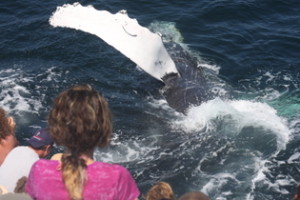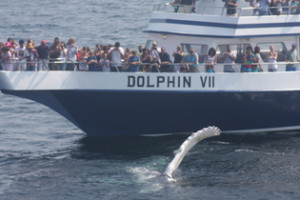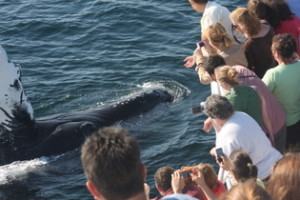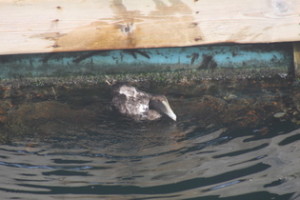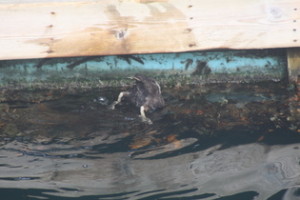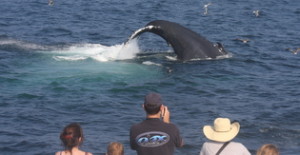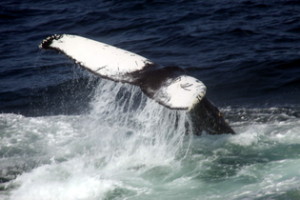Dolphin Fleet Naturalist Notebook: August 15th to August 21st
On August 15th, morning haze gave way to clearer visibility for the afternoon trips. We headed toward the triangle, an area east of Stellwagen Bank where we frequently encounter several species of large baleen whale. Upon arriving in the triangle, we found ourselves surrounded by at least 12 to 15 humpbacks, scattered within a mile radius. Though most of these whales seemed pretty low key–moving slowly and taking long dives between breaths–the trip took an exciting turn when one young whale decided to investigate the Dolphin VII.
For about 15 minutes, this little humpback circled around the boat, but seemed most fond our our starboard rail, rolling and flipper slapping, much to the delight of the passengers on the lower deck!
August 16th was another hot, hazy day, and the cool breeze from the water was a relief from the sultry conditions on land. Upon reaching the triangle, we came across a group of humpbacks with which we’ve become extremely familiar. For the past few weeks, we’ve been spending quite a bit of time with Whisk, Canopy, Pele, Lupine, Eruption, Milkweed, Bolide, and Bolide’s calf. In general, with the exception of mother and calf pairs, humpback whale aggregations tend to be relatively small and unstable, unlike the structured “pods” employed by their toothed cousins. For this reason, we’ve continued to marvel at how these whales have seemed to stick with one another for the past few weeks. What’s even more curious is that some of these whales were seen traveling together last year. In the fall of 2008, barely a day went by when we didn’t see Whisk, Canopy, their respective calves, accompanied in by Pele and Milkweed in their travels accross the Stellwagen Bank National Marine Sanctuary.
The haze persisted into August 17th as we made our way eastward past Race Point in Provincetown. Today, the same humpbacks which had seemed relatively slow-moving and lethargic for the past few days seemed to have gotten a sudden burst of energy and were delighting passengers on every trip. On the 12:30 boat on the Dolphin VI, one humpback breached so close to the boat that the passengers on the bow got wet!
Meanwhile, on the Portuguese Princess, a humpback named Music came right up to the boat, rolled on its back, and slapped its long, white, pectoral flipper down on the surface of the water.
Amongst all the levity, there was one sobering moment when we encountered a humpback named Anvil who had some squid jigs (hooks used in tuna fishing) attached to her body. Sometimes, when large whales become severely entangled in nets, a specially trained team will intervene to help to free the whale from its gear. In this case, however, removing the hooks is not a feasible option, so we will continue to photograph and monitor Anvil with the hope that she will free herself of the gear on her own.
On August 18th, we had the opportunity to spend some quality time with two other baleen whale species in addition to the ubiquitous humpback. The afternoon excursion aboard the Portuguese Princess II. Our first sighting of the day was of 3 humpbacks, several Minke whales, as well as 3 – 4 fin whales. The fin whales are the second largest whale on the planet and they can be seen in the waters near Cape Cod in nearly every month of the year. Dolphin Fleet naturalist John Conlon is our resident fin whale expert, and he recently wrote up a mid-season report about his photo-analysis of this season’s fin whale sightings. The following is an excerpt:
To the middle of July I have 63 sets of Fin Whale ID shots. Named individuals IDed this year: Breaker, Cyrano, Dali, Darth, Hook, Mottle, Nightcap, Pyramid, Rila, Ruby, Scorpion, Sagitta, Skeg, Spike, Steller, Sunspot (with her second Dolphin Fleet recorded calf), Thunder, and Trout. Unnamed though IDed individuals so far are: 07 039 (Scorpion’s 2007 calf), 07 058, 07 164, 08 015, 08 024, and 08 142. We also have a minimum of 4 unknown individuals. All of the named individuals and the unnamed 07 XXX individuals are in the Fin Whale catalogs on the boats. All of the accompanying life history sheets are up to date as of 2008 history. We have also had sightings of Amp, Belt, and Loon though these have not yet showed up on data photographs. These three are also in the onboard catalogs.
Robin Sewall of Allied Whale has sent back the match analysis for 2006 between the Dolphin Fleet Fin Whale Catalog and the Allied Whale Western North Atlantic Fin Whale Catalog. Braid, Canopener, Furrow, Goatdance, Hindpaw, Ladders, Loon, Scorpion, Shark, and Trax have been matched. Our “Sash was previously named “Trigger” and our “Boomerang” was previously named “Johnny Depp”. These names will be adjusted in our catalog to match Allied Whale. The life history information that Robin has sent will be incorporated into the onboard catalogs during this autumn’s desk-time. This information includes previous Southwestern Gulf of Maine sightings as well as sightings from other locations between New York and Maine. I am looking forward to more analysis coming back from Allied Whale as their work continues.
We had two Fin Whales come ashore on the lower Cape this year. The first was in early February on Dyer Prince Beach in Eastham. This 40 foot male was alive as it stranded but died shortly thereafter. At this length the animal would have been a bit over one year in age. The second was in late May on Herring Cove Beach in Provincetown. This 50 foot male had been dead for some short time before the southwest wind pushed it onto the beach. At this length the animal would have been about two and a half years old. I was not able to match either of these individuals to our Dolphin Fleet catalog. I mention these animals here because in each of my year-end Dolphin Fleet Fin Whale reports I’ve discussed the problems associated with photo-documentation of mother / calf pairs. I was not able to determine if these were indeed unknown individuals or if they were solely not matchable to the photos on record. Mother calf pairs are particularly challenging to photograph.
On August 19th, we headed out to the Triangle, east of Stellwagen Bank, and began our trip with sightings of 5-6 humpback whales, including Venom, Pele and Springboard. Then, something unusual happened. Of the three baleen whale species that we frequently encounter on Stellwagen Bank in the summer (humpack, finback, Minke), the humpback is the most likely to approach a boat and display curious behaviors. The Minke whales that we see generally are pretty elusive, often disappearing just as we point them out. The morning trip aboard the Dolphin VII had an entirely different experience with a Minke, however. For about five minutes, a Minke whale swam back and forth under the Dolphin VII, coming up along side the boat to check out the equally curious passengers.
On August 20th, we returned to the Triangle, located east of Stellwagen Bank, to find our regular group of humpbacks, including Pele, Whisk, Eruption, Percussion, Canopy, and Lupine. These humpbacks range in age from 7 years old (Percussion was born in 2002 to a whale named Plateau) to 22 (whisk was born to Ivory in 1987). When we have the opportunity to watch whales grow into adult animals, we are able to learn a lot about the population as a whole, including migration patterns, calving habits, and habitat choices. We hope that by tracking whales through photo-identification throughout their lives, we will be able to tackle the kinds of questions that can only be answered over long periods of time, such as how long these animals live. There are some humpbacks that we see from time to time that we know to be over 40 years old!
Today, this group of humpbacks seemed to be spending much of their time looking for food deep in the water column. The small schooling fish that these whales pursue spend their times at varying heights in the water column throughout the day, sometimes burying themselves in the mud on the ocean floor. Often, humpback whales will have to travel down to the ocean bottom (in this area, this is at a depth of about 180 feet), and use their jaw to dig up the schools of buried fish. We can make assumptions about this sub-surface feeding behaviior when we notice that they are going on longer dives and spending less time at the surface, which was what was happening today.
On our way back into Provincetown Harbor, we made sure to take note of the interesting bird life that makes this area so special. Pulling into the boatslip, we noticed a Common Eider feeding right by the float. Common Eiders are the largest duck found in the North Atlantic, and can be seen in Provincetown Harbor throughout the year. They often dive to feed on mollusks and crustaceans.
On August 21st, we returned to the same area to find that the deep dives and probable bottom feeding still happening in the early morning. As the morning progressed, the whales seemed to take a break from this sub-surface feeding, and the passengers aboard the Dolphin VIII witnessed a large humpback whale jump right out of the water in what we call a full spinning head breach! Soon afterward, a group of Atlantic white-sided dolphins arrived on the scene and began following Whisk, Canopy, Pele, Percussion and Whisk as they dove and re-surfaced.
Meanwhile, aboard the Dolphin VII, another humpback delighted passengers by lobtailing, or repeatedly slapping its tail down on the surface of the water. We don’t know what causes this behavior, but many speculate that it is a way for these whales to communicate with conspecifics over long distances.
As we headed back to shore that day, we wondered about how the rapidly-approaching tropical storm Bill would affect the ecosystem dynamics in the coming days. Would Canopy, Whisk, Pele and the rest remain together as a group? Would the storm bring in new, cold, nutrient-rich waters to the area affecting the humpback food supply? Check back next week to see how the last week in August treated our whale watchers!






